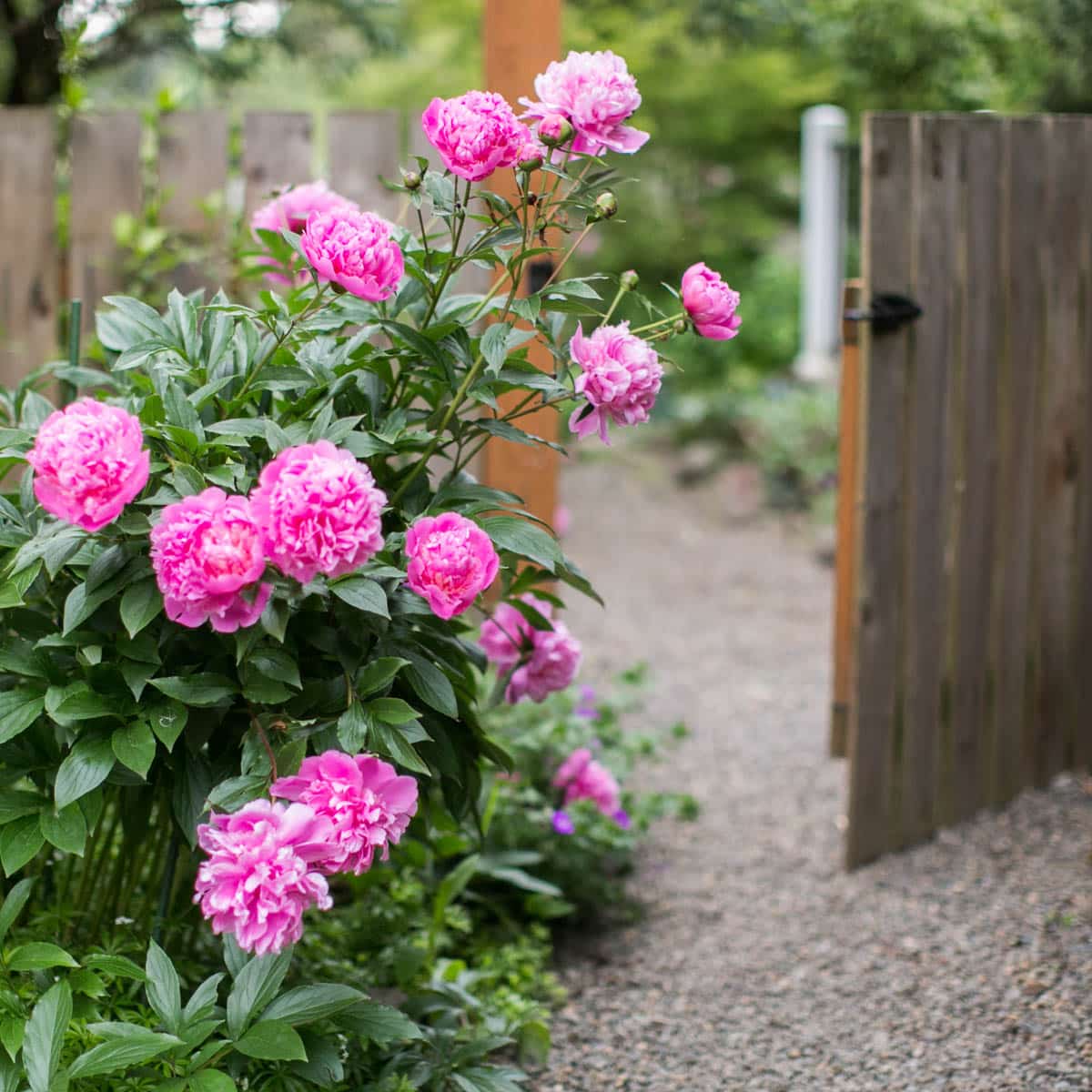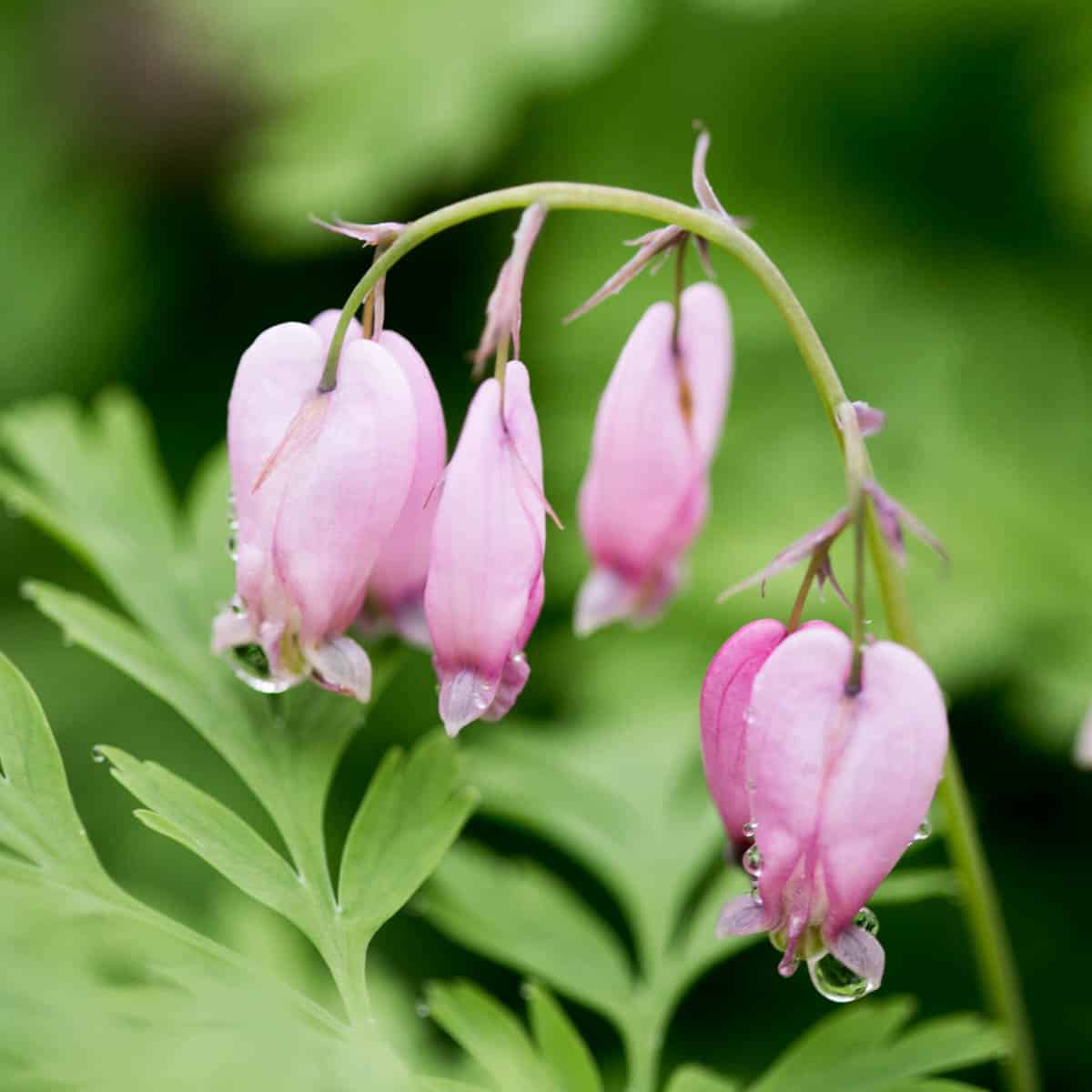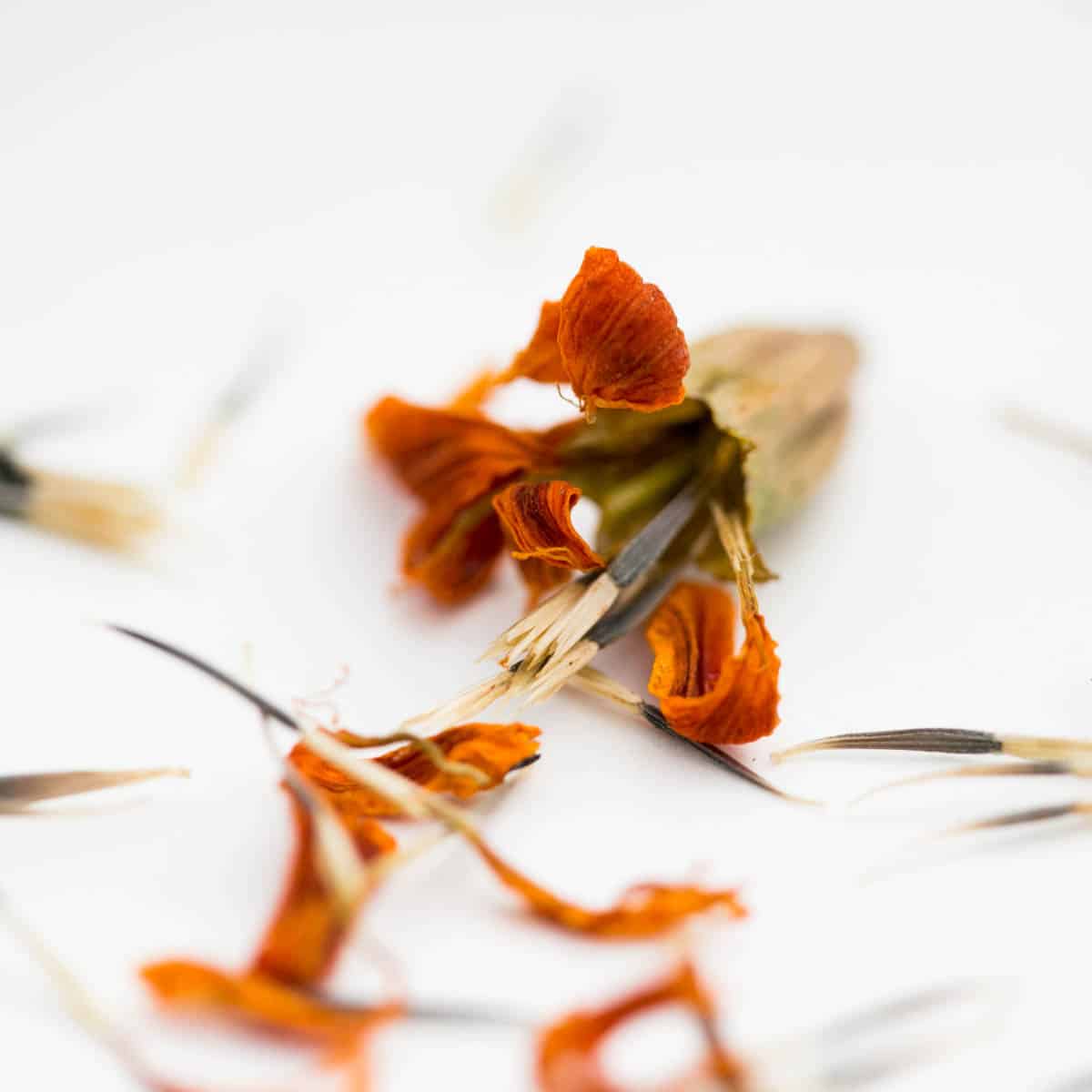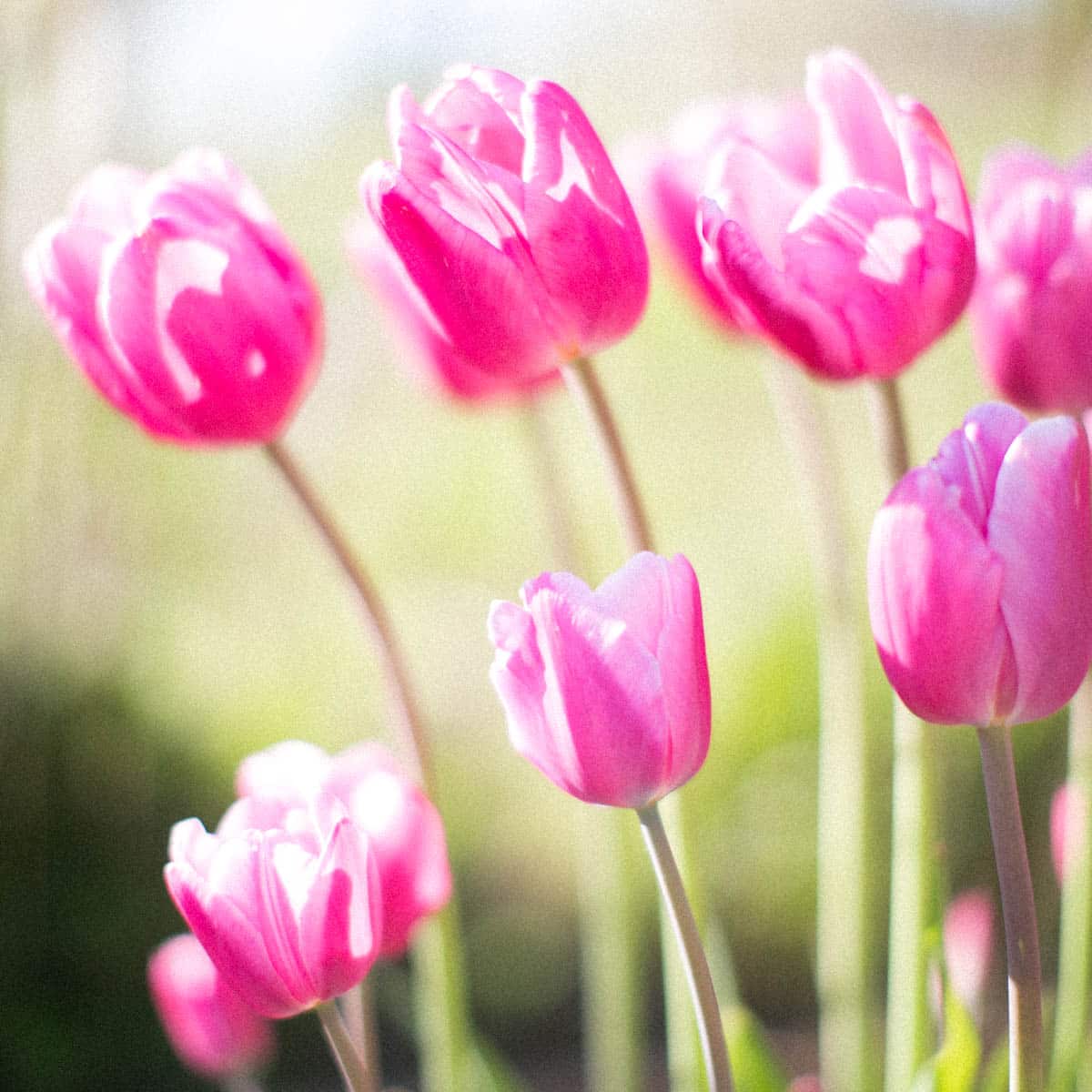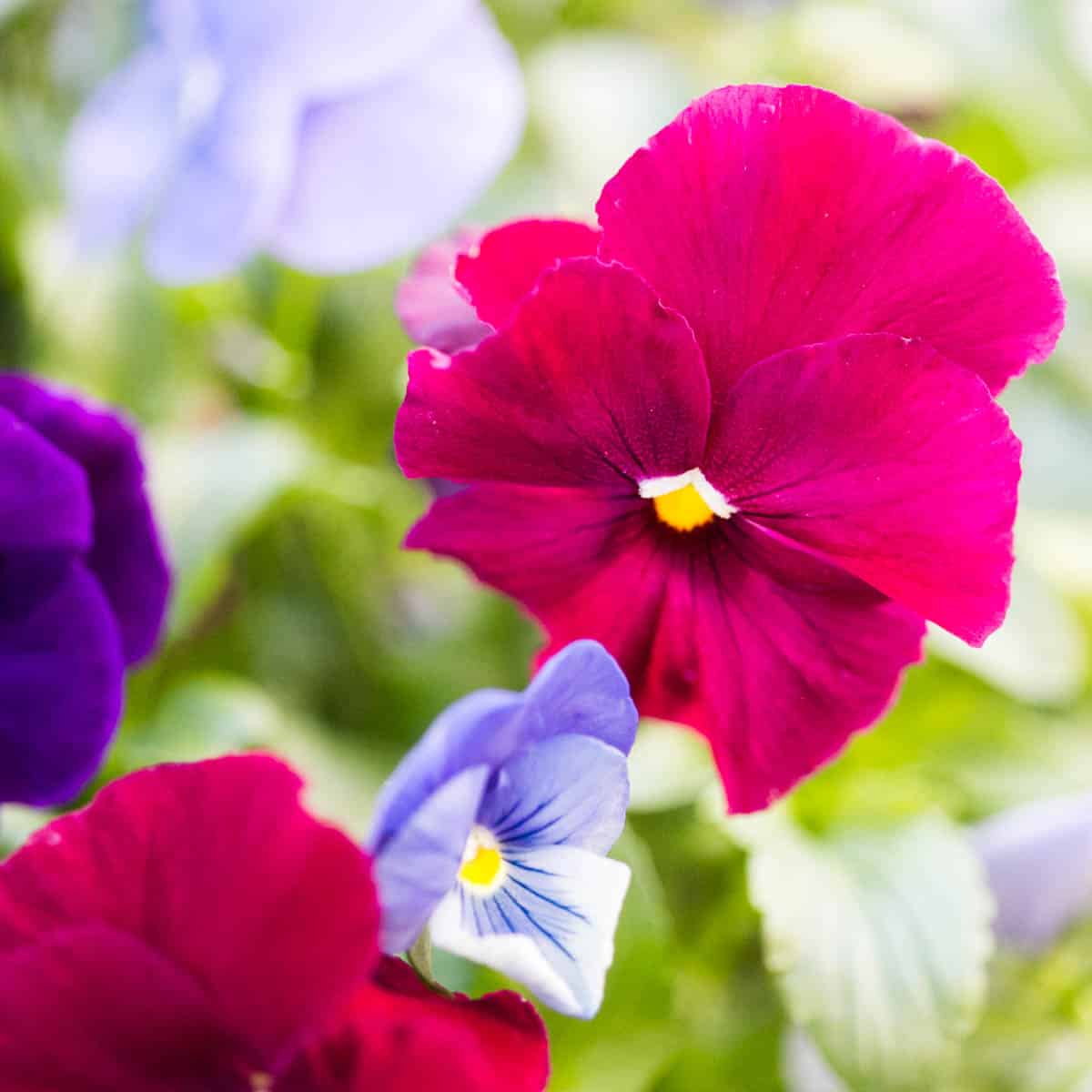How To Water Flowers (10 Best Tips For Healthy Plants)
Growing flowers is one of the most relaxing and rewarding hobbies one can have. But figuring out how much water each type of flower needs can be tricky. Some plants need less water and some crave a lot more. And giving flowers the wrong amount of water can be detrimental to your plants!

Over the years we’ve made all the flower watering mistakes so you don’t have to. This guide will teach you how to water flowers so that they thrive!
How To Water Flowers Outside: Best Tips
Each flower is different, but in general, give flowers about an inch of water each week. Always water on the top of the soil, under the base of the plant (not on the leaves or flowers). Use a hose with a watering wand so that you don’t damage your flowers or disturb the plant’s roots. Keep reading to get the best tips for watering flowers outside!
Watering outdoor plants can be confusing. Problems can arrive if you water in the heat of the day, and wet leaves at night can cause powdery mildew and other disease. This 10 tips will help you water your flowers successfully:
1. Know Each Flower + It’s Unique Watering Needs
Did you know that different plants have different water needs? It’s true! Some flowers, like hydrangeas, need a lot of water in order to thrive. And many other plants, such as lavender, cosmos, and salvia are drought tolerant.

Getting to know what’s growing in your flower bed is the first step to making sure each plant gets enough water in order to thrive.
As a general rule of thumb, most flowers need about an inch of water each week. Established, larger plants, like roses, need only to be watered every couple of weeks in moderate weather and twice a week in a heat wave. Plants in pots + containers need to be watered daily.
2. Monitor The Local Weather + Climate
Flowers need different amounts of water depending on the time of year, current weather forecast, and your local growing zone. (Get our beginner’s guide to growing flowers here).
In hot weather flowers will require more water and in cool weather they will less water.
Soil moisture is affected by both the rainfall and humidity in your local area. Dry conditions will call for more frequent watering, and during cool, rainy weather, you may not need to water at all.

(Flowers grown in pots and containers will often need daily watering , even during overcast weather).
Flowers in direct sunlight will often need more frequent watering than plants located in partial shade. And a plant will need more water during hot summer days then during the cool spring months!
It’s a good idea to keep an eye on your local weather and climate, rather than blindly watering each day. You can do this by watching the weather forecast and understanding what zone you live in, as well as just taking a peek outside!
3. Use the Right Kind of Hose Head
Water pouring out from the end of a hose can dislodge seeds and disrupt plant roots. And heavy water poured onto the top of foliage and flowers can cause damage.
Always water plants with a hose that has a gentle flow of water. Use a watering wand that has a variety of settings, and choose the most gentle setting.
A quality watering can may also be used. But if you have a lot of plants to water a hose with a gentle wand is the best option… it’s faster and easier!
Most watering cans only hold a few gallons of water and can be quite heavy.
4. Water At The Base Of The Plant (At The Soil Surface)
Always water flowers at the base of the plant, near the soil surface. This will prevent water from sitting on the surface of the flowers and leaves, which can cause flowers to rot and drop off the plant.
Overhead watering causes water droplets to travel down the plant’s foliage and get to the roots. The water may evaporate before it reaches the roots of the plant. Water droplets left on some flower buds, such as chrysanthemums, will cause the flowers to rot and drop off of the plant!

For best results, place your hose at the base of the plant, under the foliage and flowers, and water the roots deeply. Never water the tops of the plants!
5. Water Slowly + Deeply, Into the Roots
It can be tempting to give flowers a quick splash of water and call it good. But plants thrive with a long, gentle drink of water that will reach deep into the root zone.
Watering deeply will also encourage the growth of deep roots, allowing your plants to grow strong and need less water in the long run!
Apply the hose head at the base of the plant and give your flowers a long, slow drink.
6. Water Flowers At The Right Time Of Day
The best time of day to water flowers is in the early morning, before the heat of the day sets in.
During the hottest part of the day water may evaporate before the plant has time to absorb it. And watering in the late afternoon or evenings can encourage disease and powdery mildew- especially during cooler weather.

Watering in the early morning will allow the plant to dry if any extra water makes its way into the foliage or flowers (which is somewhat inevitable).
Too much water sitting on the flowers can cause rot, and in some cases cause the bloom to fall off.
While you can’t do much about the rain, you can control when you water your own plants.
Choose to water in the morning when possible to ensure that the water has time to drain off of the plant’s foliage and flowers.
Water first thing in the early morning and avoid watering at night to prevent disease like powdery mildew and fungus. Surface level soaker hoses can be a good option for consistent, even watering
7. Water New Flowers Regularly
New plants need to be watered regularly in order to establish their roots. It takes time for a new plant to establish it’s root zone and grow the deep root system that can reach and stretch for more water.
Water daily for the first one to two weeks to establish your new flowers. After this time period begin watering every few days, or as the weather and type of plant indicates.

As the roots of the plants grow deeper and more complex, the plant will be able to reach for more water.
New plants need consistent water to establish, but don’t drown them! Make sure the plant’s soil has good drainage and that the soil dries out in between watering. Proper watering is a balancing act: never over water your plants!
8. Water Flowers In Pots + Containers With Care
Flowers growing in pots and containers need special care when it comes to watering.
Potted flowers and plants will dry out quickly and often need to be watered every day, especially in dry climates.

Drainage holes are essential for flowers grown in pots and containers. Always check on the bottom of the pot to make sure that there are holes to allow for excess drainage.
Poor drainage in pots and containers can result in fungal disease and root rot, which will eventually kill the plant!
Check for moist soil in pots and containers daily by sticking your finger into the soil to see if the top layer is dry or wet.
You can also pick up the potted plant to see how heavy the pot is. A light pot or container will indicated that the plant is dry and needs to be watered.
The best type of soil for potted flowers is a quality potting soil. For best results, do not use garden soil for potted plants. Potting soil will compact inside of the container and will not drain well, especially if the soil is full of clay minerals.
A good option for ensuring potted flowers get adequate moisture is a self watering container, like this one!
*Small pots will drain quickly and need to be watered frequently, even up to twice a day in hot weather. Flowers grown in large pots will need less water, but should still be checked daily. Water flowers growing in container at the surface of the soil, just like you would with plants growing in the ground!

9. Improve Soil Drainage So Plants Thrive
Poor soil can affect how your plant receives the water you give it! Clay soil can make it hard for water to drain, and dry soil makes it hard for the water to be absorbed.
The best soil type for flowers is referred to as sandy loam. It contains the right amounts of sand, clay, and organic matter. These elements allow the soil to retain just enough moisture while still allowing excess water to drain from the soil.
Soil will often need to be improved so your plant can absorb just the right amount of water.
Clay soil needs more drainage and can be amended with organic matter such as bark, compost and peat moss.
10. Apply Mulch To Conserve Water
Our final tip is to apply mulch around your flower garden! Mulch helps protect the plant’s roots from the intense rays of the sun, and can be an effective way to conserve water.
Soil exposed to the sun will dry out more quickly, and mulch can help conserve water. Apply mulch around the flower beds in the form of bark chips, organic compost, or small stones.
Low growing perennials, such as creeping phlox, can also provide an effective form of mulch.
Bonus Tip: How To Prevent Root Rot + Fungal Disease
Root rot is a condition where poor soil conditions cause the roots of a plant to rot.
Root rot is caused when excess water is not able to drain from the plant’s roots. Mold and fungus form, causing the plant’s roots to turn to mush and decay. Left untreated, root rot will kill the plant.
The easiest way to prevent root rot is to make sure the plants have plenty of drainage available. Heavy clay soils can make it hard for water to drain from the roots of the plant.
Signs of root rot include yellow, drooping leaves, foul smelling soil, mushy stems and slow plant growth.

To avoid root rot, make sure the soil is dry before watering your plant. Stick your index finger into the soil to check moisture level!
Use a quality potting mix in containers and pots and make sure there is plenty of drainage. This will give your plant the best chance of survival.
To prevent root rot, well-drained soil is essential for plants growing in the ground!
Signs of Underwatered Flowers
Plants in need of water will send us clues. Here are a few signs that your flowers need to be watered:
- Drooping or wilted leaves
- Compressed, compact soil (or soil that does not retain water easily!)
- Yellow leaves
- Slow growth or stunted growth
- Dry + brittle foliage and stems
- Lack of flowering
- Wilting
Even established plants need to be watered during the heat of summer, so be sure to give your flowers plenty of water throughout the summer- combined with great soil drainage! The good news is that most plants can recover from a lack of water once consistent water is applied.

How To Water Flowers While On Vacation
Keeping flowers adequately watered during the summer months can be a challenge if you like to travel! But flowers need consistent care and watering. You can meet their hydration needs with these ideas:
- Offer to trade flower watering services with a trusted friend or neighbor. They likely want to travel too, and you can take turns watering each other’s plants!
- Hire a trustworthy teen that you can train to water your flowers. Pay them well, and check in with their parent to make sure the job gets done correctly.
- Install drip irrigation. Drip irrigation lines are a great way to make sure your flowers get the water they need, even when you aren’t there!
FAQ’s On How To Water Outdoor Flowers
On average, flowers growing in the ground need about one inch of water per week. But how much water you give your flowers will depend on several factors. The local weather and rainfall will affect how often you need to water. During hot weather many flowers will need more water (unless they are drought tolerant). And outdoor container plants will need more water than those growing in the ground. Always check container plants daily.
Plants growing in the ground do not need to be watered every day, unless the weather is unusually hot and dry. Flowers growing in pots and containers need to be checked daily and watered every day. The best way to water plants: water deeply and less frequently rather than giving them just a little water at a time. Watering deeply encourages a healthy root system.
Overwatered flowers will have droopy yellow leaves, stunted growth, and have a wilted look to them. To prevent overwatering, make sure the soil has good drainage and allow the soil to dry out between giving the plant supplemental water.
Keep a close eye on your plants during heat waves. During hot weather, water potted plants daily or even twice daily. For larger plants that are established, increase watering sessions to twice a week.

Final Thoughts
How much moisture do flowers need? And how often should you water them?
The answer really depends on the type of plant, whether it is grown in the ground or in a container, and the local climate and weather conditions.
In general, flowers need about an inch of water per week. During the hottest months flowers will need to be monitored daily for their water needs, and water applied more frequently as needed.
Follow the ten tips in this article for complete flower watering success!

